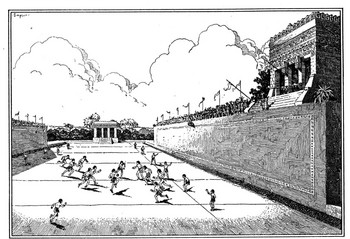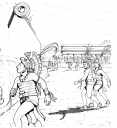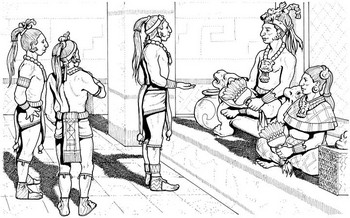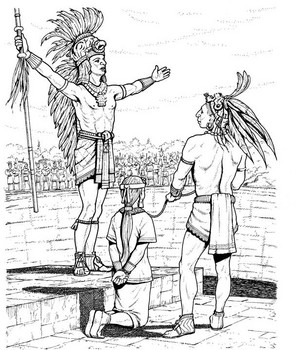The
Mayan Ball Game: A Deadly Sport
One
of the ways that the Mayan peoples competed against each
other was by playing what has been called the Ball Game.
They used a rubber  ball,
about 20 inches in diameter, to play the Game, which was
played on a stone "court" whose measurements varied. (The
largest one found so far measures 459 feet by 114 feet.) The
court had walls that sloped inward, and hanging high on the
walls were stone rings.
ball,
about 20 inches in diameter, to play the Game, which was
played on a stone "court" whose measurements varied. (The
largest one found so far measures 459 feet by 114 feet.) The
court had walls that sloped inward, and hanging high on the
walls were stone rings.
 The
goal of the game was to pass the ball around, without having
it touch your hands, and then get the ball to pass through
one of the rings. Since the rings were so high and players
were not allowed to use their hands, it was extremely
difficult to get the ball through a ring. In fact, when a
player did manage to get a ball through a ring, that usually
ended the game. The game ended otherwise when the ball
touched the ground.
The
goal of the game was to pass the ball around, without having
it touch your hands, and then get the ball to pass through
one of the rings. Since the rings were so high and players
were not allowed to use their hands, it was extremely
difficult to get the ball through a ring. In fact, when a
player did manage to get a ball through a ring, that usually
ended the game. The game ended otherwise when the ball
touched the ground.
 The
Mayan Ball Game was a solemn experience, filled with ritual
importance. Religious leaders attended, as did most
chieftains and other government leaders. Sacred songs were
sung and played. Other religious activities took place as
well.
The
Mayan Ball Game was a solemn experience, filled with ritual
importance. Religious leaders attended, as did most
chieftains and other government leaders. Sacred songs were
sung and played. Other religious activities took place as
well.
 The winners of the game were treated as heroes and given a great feast. The penalty for losing a game was sometimes unusually harsh: death. The leader of the team who lost the game was sometimes killed. This fit in with the Mayan belief that human sacrifice was necessary for the continued success of the peoples' agriculture, trade, and overall health.
The winners of the game were treated as heroes and given a great feast. The penalty for losing a game was sometimes unusually harsh: death. The leader of the team who lost the game was sometimes killed. This fit in with the Mayan belief that human sacrifice was necessary for the continued success of the peoples' agriculture, trade, and overall health.
The
game was like games and sports that people play today in a
few ways:
- The
players were working as a team to beat another team of
players
- The
goal was to get the ball through a hoop
- The
goal was also NOT to touch the ball with one's hands,
like soccer is today.
- Huge
structures were built just for playing
- The
games attracted very large numbers of people to
watch
- Gambling
on who would win was common